#louis le breton
Explore tagged Tumblr posts
Text

Louis Le Breton (1818–1866) - Danse du sabbat, 1863
illustration for Jacques Collin de Plancy's 'Dictionnaire Infernal'
#louis le breton#danse du sabbat#dictionaire infernal#19th century art#19th century#demon#witches#occult#horror art#dark art#art#book illustration#illustration#engraving
290 notes
·
View notes
Text

All credit goes to Arcane Bullshit (the art itself is by the 19th century French artist Louis Le Breton, who was mostly known at the time for marine and nautical art but did sketch up 69 demons because, as the French say, Nice.)
28 notes
·
View notes
Text

“Sakimouni ou Saki-Mouni” by Louis Le Breton 🐰🌕
Published in Dictionnaire Infernal by Jacques Auguste Simon Collin de Plancy (1863) 🤘🖤
Wikimedia Commons
#sakimouni#dictionnaire infernal#louis le breton#collin de plancy#hate#rabbit#demonolatry#theistic satanism#spiritual satanism#satanic witch#dark pagan#dark paganism#paganblr#witchcraft#witchblr#occult#left hand path#demons#full moon#dark art#art#19th century art#spirituality
37 notes
·
View notes
Text

GROTESQUERIES IN ANCIENT OCCULT DEMONOLOGY -- TERRORS & ENEMIES OF MAN.
PIC INFO: Resolution at 1272×1600 -- Spotlight on an occult demon illustration, artwork by Louis Le Breton for the 1863 edition of "Dictionnaire Infernal" (book on demonology, English: "Infernal Dictionary") by Collin de Plancy.
EXTRA INFO: ""Diable," a general name for demons. It comes from a Greek word meaning Satan, fallen from heaven, but devil signifies any order of malicious spirits, especially those which are the enemy of man."
Source: www.flickr.com/photos/13490215@N08/3372933111.
#Dictionnaire Infernal#Infernal Dictionary#Louis Le Breton#Louis Le Breton Art#Demon#Ancient Demon#Ancient Power#Occult Demon#Occultism#Demonology#Collin de Plancy#Illustration#Louis Le Breton Artist#Demons#1860s#Dictionnaire Infernal 1863 Edition#1863
3 notes
·
View notes
Text
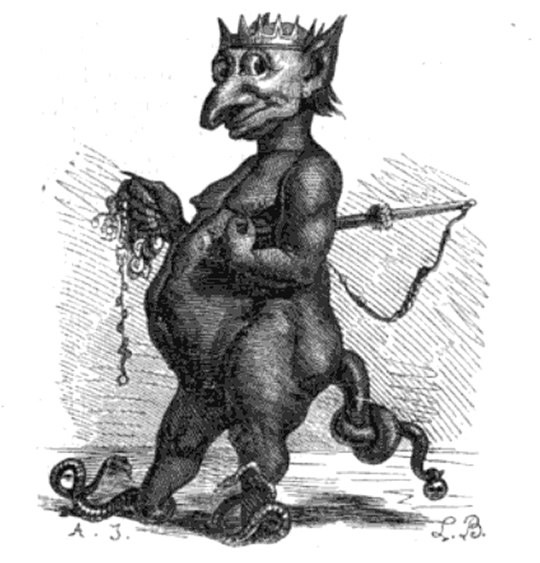
Abraxis from Dictionnaire Infernal by Louis Le Breton
#Louis Le Breton#halloween 🎃#vintage#illustration#vintage illustration#abraxis#demons#demon#demonology#Dictionnaire infernal
9 notes
·
View notes
Text
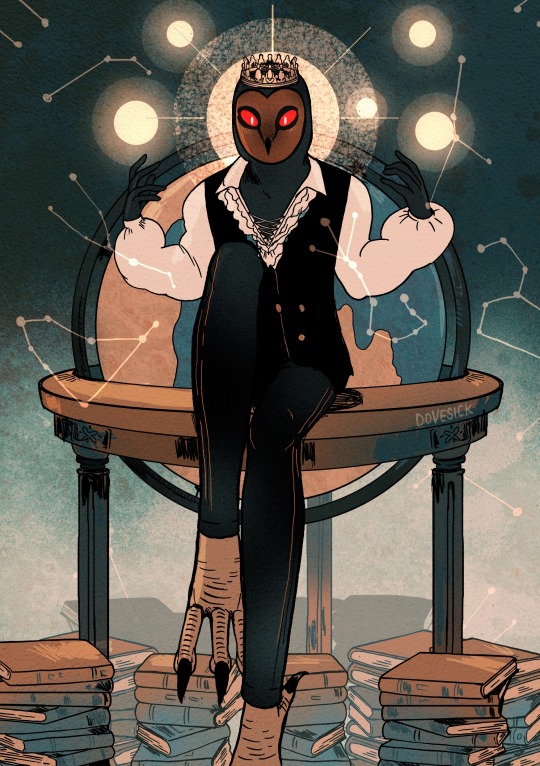
stolas, the demon astronomer
#demon art#lemegeton#anthro art#furry art#bird anthro#stolas#stolas goetia#this is the first of a series based off louis le breton’s lemegeton illustrations#i’m absolutely obsessed with them#there’s so many cool ones including lots of bird demons#but stolas is my favourite bc he is an adorable long leggy owl#idk if u guys have seen the pics#he’s so cute ;A;#i think i might draw scox/shax next#he’s a super cool stork#i made stolas a melanistic barn owl bc their feathers look like galaxies
66 notes
·
View notes
Text
goetia beelzebub you will always be famous .

1 note
·
View note
Text

Image of Barbatos from the Dictionnaire Infernal by Louis Le Breton (1863 CE), based off of engravings by M. Jarrault.
129 notes
·
View notes
Text
asdfjklalskdf omg look at this illustration of stolas I fucking love him!!!! he’s just a lil guy :)

not me going on a wikipedia rabbit hole about the ars goetia/lesser key of solomon lore because of goddamn helluva boss
16 notes
·
View notes
Text
The French Crown Jewels Theory - Parts 1 & 2

The gem in Undertaker's ring is 'diadochos', the Phantomhive Family Ring is indeed a diamond, and Sirius (r!Ciel), Canopus, Vega, & Polaris all possess their own gems as well. All of this jewelry was sourced by Undertaker from the French Crown Jewels that were stolen/went missing in the midst of the French revolution of 1792.
Alright y'all, once again I am back on my medieval French literature shit. This time in Latin! Fun stuff. No poetry analysis in this one, thank God. Instead, I got to go back in time to my years wasted spent studying biochemistry! Fuck me!
I have tried to find evidence of this being discussed online previously and have come up empty (obviously the hope diamond has been discussed, but not in the context of the Golden Fleece), but please let me know if this has already been theorized and I just missed something!
The gem in Undertaker's ring is not a diamond but a mineral that was once known as Diadochos. From ancient Greece through to the middle ages this mineral was considered sacred and powerful, thought to be capable of summoning and holding the 'shades of the dead' and making demons clearly visible to its user.
The gem being Diadochos would also explain the color difference of the ring between season 1 of the anime (green) and what would later appear in further seasons and in the manga (unclear....no pun intended). It also provides a link to the French Crown Jewels...
Which brought me to what I believe is a confirmation that the Phantomhive family ring being sourced from "The French Blue" diamond (a portion of which is now known as The Hope Diamond) as was seen in season 1 of the anime will become canon in the manga. I also am going to predict we will meet a certain grim reaper named Hendrik Fals that's based on a real person.
Not only that, but the idea of another ring with a sister diamond (as seen in the anime with another portion of The French Blue) was an interpretation of what will happen in the Manga. R!Ciel is likely in possession of The Bazu Diamond, which was a part of Louis XV's insignia of The Order of The Golden Fleece. Canopus, Vega and Polaris likely hold the three yellow sapphires that surround the Bazu Diamond, and I believe the other diamonds in this piece have something to do with Undertaker's other mourning lockets.
This also supports my theory of Undertaker being a Breton (from Brittany, France) as I believe he's represented by the dragon called "le Côte-de-Bretagne" in the insignia. And of course, that he was the one to originally gift the Phantomhive family ring to Ciel's grandmother Claudia as a symbol of his devotion and commitment to her, and in doing so "cursed" her and her family (it's a metaphor y'all)
The French Monarchy had no shortage of drip, you think only one measly giant ass diamond went missing when people's heads were getting chopped off? Buckle up, I fear this is going to be a long one. Trigger warning for discussion of suicide and mental illness.
Let's get into it.
Part One: Undertaker's Ring
In researching French medieval age jewelry for my Floire et Blancheflor series, which involves two rings (one of which is magical), I came across a gemstone that was noted to be "the most powerful" (or something along those lines) but I'd never heard of it before - Diadochos/Diadocos And then I googled it, and nothing came up. I had to dig into scholarly articles and Latin text to get info on this, and even then it's sparse.
There were three main sources I could find; two books on minerals hailing from ancient Greece, the other a popular book from the middle ages - 'De Lapidis' by Marbode de Rennes. Translated into several different languages shortly after publication, the original Latin text was written in the late 11th century by a French bishop from - say it with me everybody - Brittany.
Coincidence? Maybe. But I doubt it. I really need to finish my Undertaker is from Brittany write-up...
All these sources make similar and frustratingly brief claims, as neatly summarized in one article on the the ancient Greek text Tetrabiblos;
1. The stone diadochos is similar to the beryl. 2. It is as useful for divinations through water, and for the summoning of shades (adductionibus umbrarum) as no other stone. 3. Furthermore, it makes the appearances (effigies) of all daemons thoroughly visible. 4. Do not apply it to someone dead (=a corpse), because it is opposed to the deceased. 5. For this stone is divine and sanctus and santified by a perpetual consecration.
Side note - I will absolutely be making another post about Tetrabiblos and it's companion volume Almagest. Written in the 2nd century by Claudius Ptolemy, they're the respective astrology and astronomy bibles of the middle ages. Tetrabiblos literally means "four books", and it's Latin translation is titled Quadripartitum means "four parts". There are some very interesting notes about demon summoning in this. All of Claudius Ptolemy 's books are addressed to an unknown person named Syrus. He also has what appears to be a relevant volume on music (this guy REALLY likes fours...) looked to see if anyone had mentioned this in a theory before and when I couldn't find anything I was shocked. Let me know if I've missed a post cause there is absolutely stuff to be discussed from Claudius and these books - I just can't get into it or this post will be 5000 years long.
So, Diadochos is actually now known as Beryl.
Whereas diadochos means "heir, successor", the word "beryl" is Old French for a "precious blue-green color-of-sea-water stone".
It's worth noting the element "Beryllium" is #4 on the periodic table of elements.
Gemstones high in beryllium include beryl (aquamarine, emerald, red beryl) and chrysoberyl. It is a relatively rare element in the universe, usually occurring as a product of the spallation of larger atomic nuclei that have collided with cosmic rays. Within the cores of stars, beryllium is depleted as it is fused into heavier elements.
Diamond is element #6... Interesting.
This stone was, as I mentioned, considered sacred and magical - used often in divination, and to create crystal balls. But it also had much more practical uses -
When the first eyeglasses were constructed in 13th-century Italy, the lenses were made of beryl as glass could not be made clear enough
Well that sure is interesting...
Season 1 vs Canon - Fight!
As I said, this mineral is now known as 'beryl' - but you would be more likely to recognize the names we use to refer to the different colours beryl comes in - morganite, heliador, gosenthite, aquamarine, and emerald. You're likely familiar with the signature colors of some of these gems, all of which are different shades of the same mineral.
As previously mentioned, 'beryl' is the Old French word for the blue-green color of the sea.
I think it's pretty widely accepted that the creators of season 1 were given information from Yana that hadn't yet been released to readers of the manga. The most obvious example of this (so far) is the 'Undertaker is a reaper' reveal. Now I have no idea what the creative process behind developing an anime is like, how much contact or creative input Yana Toboso would have had, but I'm going to go out on a limb and suggest it's possible that admist a wealth of information that was handed over, there was a note that said Undertaker's ring was one of 'Beryl', and the creative team went with the 'traditional' Beryl color of blue-green - which is why people think the ring in season 1 is set with an emerald.
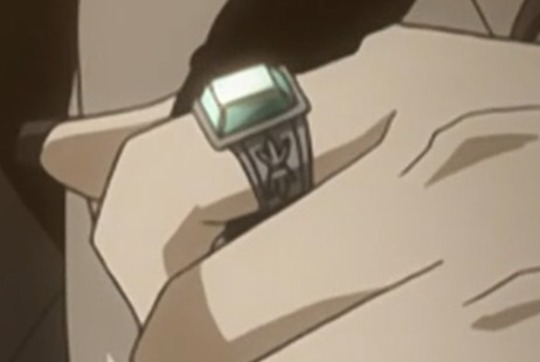
Peep the fleur de lis 👀 y'all they knew not to leave THAT out at the very least.
And yes, emerald is a shade of Beryl - but this was never intended to be an emerald.
The difference in color is something that's always really bugged me, so I'm relieved to finally have an explanation that makes sense (to me at least). Now as for the colour Yana chose...
So What Fucking Colour is it Anyways?
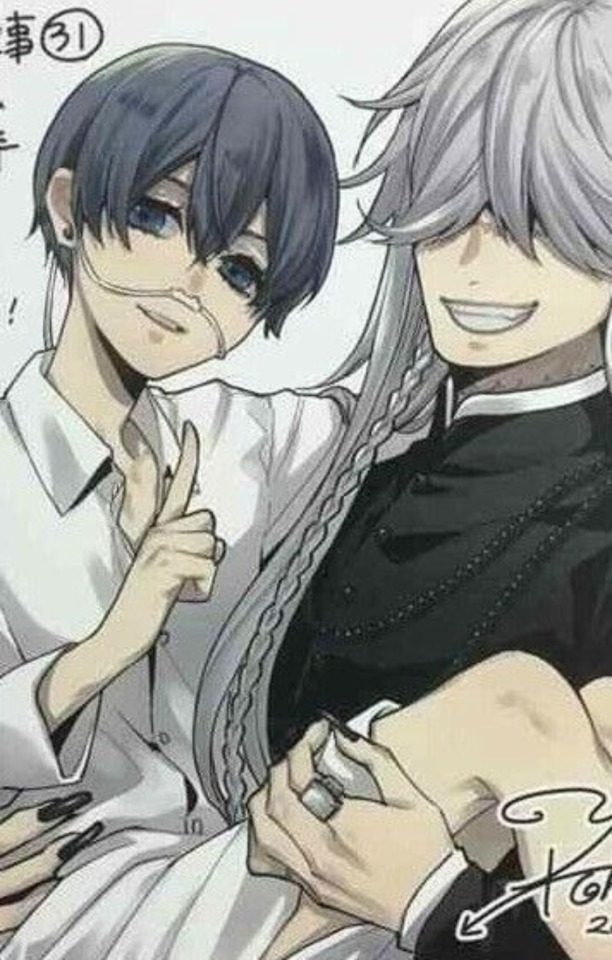

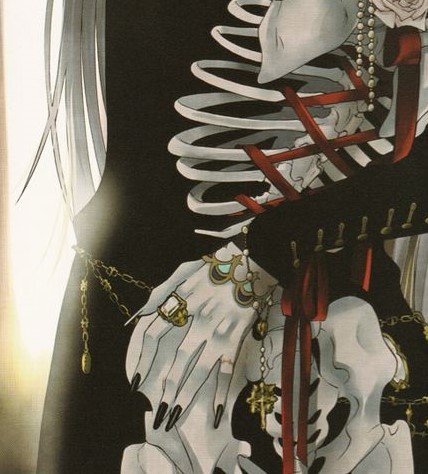
If you know of better official art that demonstrates the color of this damn beast of a rock on his hand, feel free to point me in its direction because I was struggling. There seems to be a pattern of colour-washing the art or appears in, or Undertaker posing in a way that hides the ring from view.

This is a much-discussed character design that shows a lock of hair embedded/underneath the gem of Undertaker's ring (we will return to this detail in a future theory), as well as confirmation of the fleur-de-lis on the side of the ring, and then of course the gem itself. Perhaps a light yellow, or perhaps just showing the gold backing through the translucent stone?
We do get some shots from the anime in BOC and BOA respectively;
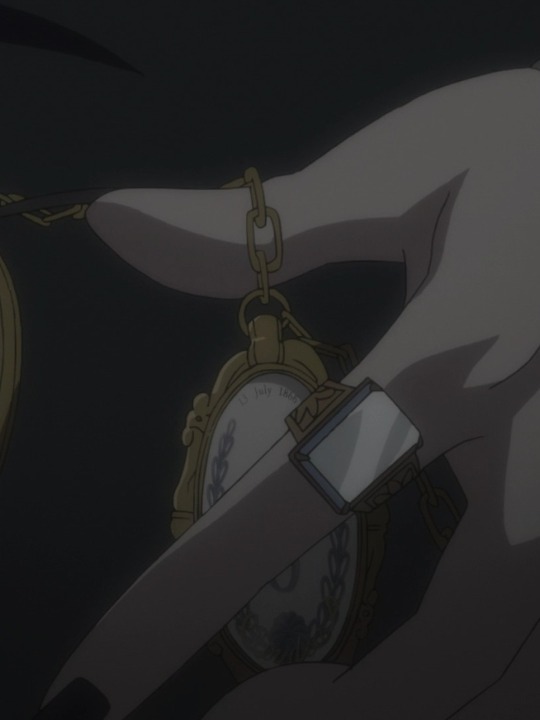
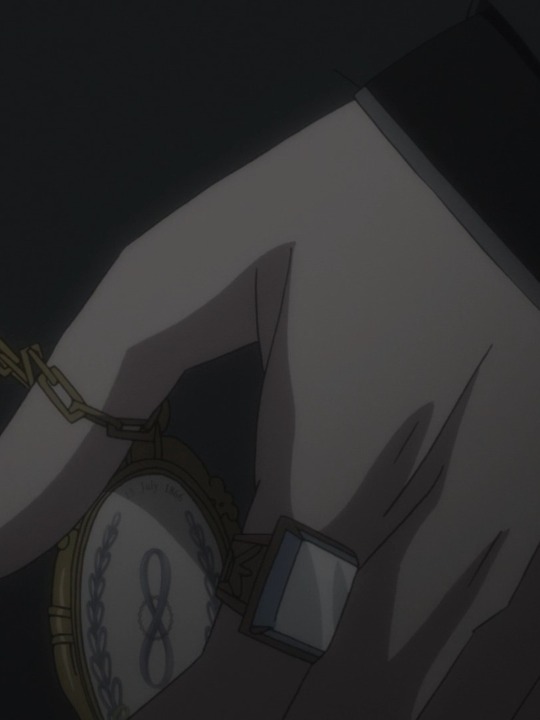

Well, I get why people think it's a diamond.
Even in official artwork sometimes it's white, sometimes it's yellow, sometimes it's tanslucent , sometimes it's a little...blue, dare I say?
Back! on! my! Chemistry! Shit!
Alright, and now we get into the chemistry of it all. I know, first history and now this bullshit. I'll keep it brief; excuse me my nerdy nostalgia for a spectroscopy graph.
Basically, the different colors of Beryl are due to impurities within it (unclean one!). The purest form of Beryl is goshenite, which is clear/white.

The other colours are formed based on what ions (charged atoms) exist within them as impurities - for emerald it's Chromium, for Morganite it's Manganese... And both the yellow and aquamarine colors are due to the presence of iron (element #26) ions.
Now when you think of the gem aquamarine, you probably think of a pale blue; and for most gems sold nowadays that true. As a March baby it's my birthstone, and I've been gifted many a pale blue aquamarine birthstone reminiscent of the water it's named for....
Oh wait a second, who else is a March baby? Motherfucking Cedric K. Ros(signol), that's who!
Okay, I'll admit; I'm sort of invested in his ring being an aquamarine gem because it would relate back to both his birthday and his 'rebirth' as a reaper when he drowned, and the more I string these crazy red threads through French history the more I'm convinced these details are critical to his character. So yeah, I'm biased - but before you write me off as delusional, just hear me out, because the chemistry is in my favor!
The best-known green beryl is emerald, which obtains its colour from Cr and/or V ions. However, a different green colour can be obtained from mixtures of the yellow and blue beryl chromophores described above. When yellow and aquamarine chromophores are simultaneously present, the colour becomes light green. Depending on the relative concentrations of the two chromophores, the colour can vary from light yellow-green to light blue-green. Shang et al. (2022) classified the colours of beryls containing these chromophores into five groups, from yellow to light blue.
Fridrichová et al. (2015) heated crystals of deeply coloured aquamarine and yellow beryl to different temperatures. After heating one of the yellow crystals to 300°C it was still yellow. Heating of additional yellow beryl samples to 500°C and 700°C in each case resulted in light blue aquamarine colouration. Another yellow crystal heated to 900°C lost almost all its colour.

All this to say; apply enough heat to a green beryl and it will turn to yellow, to aquamarine, to clear.
Here's a little basic color theory refresher for you as well; blue and yellow pigment together make green, whereas blue and yellow light create white light.
Here are some examples of various coloured aquamarine gems, some set in gold bands like Undertaker's, based on the verbiage with which they were advertised;
1. A clear goshenite gem; 2. A pale aquamarine; 3. A yellow aquamarine



4. A clear blue aquamarine; 5. A yellow aquamarine; 6. A yellow aquamarine



5. A yellow Aquamarine; 6. A yellow Aquamarine; 7. A pale blue aquamarine



All of these could conceivably be made from the same source mineral - what changes its nature is the amount of heat that's been applied to it.
Neat, huh? And I would argue symbolic for this story. Both in that there's a whole lot of manors being burned down, but also as a metaphor for life experiences and trauma.
The scientific debate on nature vs nurture continues, but it seems to be proven again and again that the way we develop is significantly weighted towards nurture. Nature plays its part, for sure - if there weren't iron ions in these gems, the fire wouldn't have an effect on the gem's color. It might get a little toasty, but then it would cool off and have no lasting effect on the gem's appearance, structure, chemical composition... But since there are iron ions that are a part of the gem, that were within it when it first formed (which it can do nothing to change), it is significantly impacted by its environment. If the fire gets hot enough, it can lose all of its color.
For someone like Undertaker, who I believe to have been (and continue to be) mentally ill, depressed, and ultimately suicidal to wear this ring is symbolic of the mental illness he was born with, and the trauma he experienced living in Brittany from 1331-1366 (Black Plague, The Breton War of Succession, and The Hundred Years War between France and England).
I've seen it mentioned in discussion that Sebastian is a physical representation of Ciel's trauma - a physical demon to represent his metaphorical demons. I also see the story of Black Butler as an allegory for generational trauma and inherited mental illness; that which we bestow upon our children like heirloom jewelry.
However, this metaphor is also sort of hopeful in that the change isn't necessarily permanent. The color of the gem can revert back towards its original hue over time depending on the circumstances.
Undertaker & Water
There's a panel in the manga that implies Undertaker's method of suicide was drowning. I currently have two different theories on where he drowned that are duking it out for the top spot. Currently the top contender is that he jumped from La Pointe de Plouha, the tallest cliffside on the Breton coastline, and drowned in the waters separating England from France - The English Channel. Plouha has a very interesting myth about the Ankou, the Breton version of the grim reaper, and I find it poetic for him to be reborn in the waters seperating him from a country he'd been at war with for most of his life - especially given that he would proceed to fall in love with a British Aristocrat.
This French crown jewels theory seems to support the idea that he drowned in the English Channel as I believe he's represented in the insignia by the dragon, le Côte-de-Bretagne (Translates literally to the coast of Brittany) - but I'm not ready to fully call it yet. Withholding my final judgement for the moment.
Regardless, if Undertaker did drown, his character being associated with Diadochos/Beryl/Aquamarine, stones intrinsically associated with water, makes a lot of sense. Consider after all, the arc where we first really met him - book of the Atlantic takes place in the middle of the ocean.
The Romans believed Aquamarine to be sacred to Neptune, the god of the sea. Supposedly the gems came from mermaid's treasure chests (they're actually formed in hydrothermal vents) so saiilors would wear it for protection against shipwreck. They also thought it had healing properties because the gem would appear to disappear when submerged in water.
Well, Undertaker did disappear when submerged in water, didn't he? He was reborn as a reaper, only called himself by his serial number 136649 (an oddity even amongst reapers, who have all also committed suicide), and (externally at least) completely disassociated himself from his former life.
Cloudia and Undertaker share the zodiac sign Aries, a fire sign, so there's symbolism in water killing him. Extinguishing his flame, so to speak.
As mentioned in Tetrabiblios, Diadochos is useful for divinations in water, and the same is said of beryl;
Beryl was a popular skying stone in the Middle Ages. Most sources indicate that this was done either through dowsing, attaching the beryl to a thread over a bowl of water, with the crystal just touching the water...An alternative method involved throwing the stone into a bowl of water and reading the disturbance it created.
Undertaker threw himself into a body of water, then revolted against Reaper HQ, had an affair with and sired two illigitimate half-human children on the Queen of England's guard dog, and went against the laws of Gods and men to raise the dead. If thats not a disturbance, what is?
There's also a religious aspect to look into. Book of the Atlantic takes place over the holy week that precedes Easter - and I have a theory outlining why I believe both he and Cloudia's birthdates fall on 'Holy Monday'. He was also born on the day of the Annunciation - that's the day that an angel came to Mary to tell her she'd been chosen to carry the Incarnation of God. He's also associated with the white lily, a flower associated with Easter, and he carries a lot of religious symbols. His cassock, prayer beads, and the crown of thorns on his scythe and on Cloudia's locket are not there for shits and giggles. This religious symbolism ties into my theory on the circumstances of his birth, and the thread that I believe ties the lockets together...
...all of which I've been in the process of researching and writing for a hot minute, I just don't know how to keep it brief 😩 I'm a dog chasing squirrels.
Anywho, religion - there is the concept of Baptism. Undertaker being reborn into a new life when he submerged himself in water.
Baptism is a Christian sacrament of initiation almost invariably with the use of water.It may be performed by sprinkling or pouring water on the head, or by immersing in water either partially or completely, traditionally three times, once for each person of the Trinity. The synoptic gospels recount that John the Baptist baptised Jesus.
Speaking of Jesus, since he and Undertaker seem to be so tightly knit, Jesus performed seven canonical miracles, and two of the most notable (imo) are with water; walking on it, and turning it to wine. The last of course was Lazarus, raising the dead...
Magical Properties
I'm not suggesting that this stone actually grants Undertaker any abilities, but it's interesting that the supposed magical properties align with his character attributes.
It's been theorized that Frances is always making comments on how slovenly Sebastian's appearance is because she has the ability (on some level) to see his demon nature due to her half-reaper blood that she gets from her father, Undertaker/Cedric. This is somewhat supported by Ladger and Sascha speculating Ciel's ability to see them is from his bloodline - which is of course, where we got Cedric K. Ros- from!
Then there is of course summoning the shades of the dead and holding them here on earth. And I find it super interesting that this specifically mentions not to "apply it to a corpse" because "it is opposed". Like, what the heck does that even mean? A vague warning that if you fuck around, you'll find out? I have not been able to find any further details on what this might be referring to, but it sure sounds ominous.
And finally a note that the stone itself is "perpetually consecrated" - unable to be desecrated or corrupted. The stone is "divine". I will have to come back to this in another theory, because it's a can of worms, and this post is long enough.
Finally, I must note that according to the French wiki, Aquamarine is a symbol for a happy & faithful marriage. Specifically 23 years of marriage.
La couleur marine de ce minéral fait qu'il a été utilisé comme talisman pour les marins. Symbole de fidélité entre jeunes mariés, c'est un cadeau censé leur garantir un mariage heureux, ce béryl symbolise 23 ans de mariage.
Frankly it doesn't seem to have the most reliable source, but it's worth noting that is you take Claudia's age when she died, 36, and subtract 23 years, you get an age of 13.
Giving you maaaaaaaad side eye Undertaker 🤨.
Now to be clear I don't think they ever actually got legally married; perhaps not even "spiritually" married. However it is very possible that they met in 1843 - Undertaker likely deserted the reapers around the time of Queen Victoria's ascension to the throne in 1837. We don't know what he was doing during this time, what goal he might have been working towards - but befriending Claudia's father, the current guard dog of the new queen, might have been part of it.
I have my own personal head-canon that he worked as a jeweler during this time, but I don't have any real support for that - just that it makes sense given all this damn drip the guy has, it would be a way to familiarize himself with the British Aristocracy and perhaps even The Royal Family themselves, and the black market trade of stolen jewels might have been of particular interest to him. More on that in a minute.
Anyways it makes sense within the narrative for them to have met when Claudia was 13, as much we might find him even knowing her at that age icky, because of how significant the number 13 is to this story.
Part 2: The Hope Diamond & The Hirsch Aquamarine
Alright so as discussed - Undertaker's birthstone is aquamarine. Let's say for the sake of this argument, you agree with my interpretation of Undertaker's ring being a pale aquamarine gem. While he and Claudia share a zodiac sign, and a birthday on the same 'day' of Easter, they were born in different months. Cedric in March, Claudia in April. Which makes Claudia's birthstone a diamond.
The Origins of the Hope Diamond
Going back to season 1 of the anime, where the animators had more knowledge then we did about future events (even if they were interpreted oddly), they made the Phantomhive family ring not a sapphire but a blue diamond. Specifically, a gem cut from "le Grand diamant violet de Sa Majesté" a French Crown Jewel that was stolen in 1792 in the midst of a revolution. This is commonly referred to as "Le Bleu de France" in English circles, but the French actually called it purple, not blue.
Back to chemistry briefly for this point - in a similar concept to what has previously been discussed with Aquamarine and Beryl, impurities in the French Blue is what provides it with its distinctive colour - specifically, Boron (element #5).
Visually, the gray modifier (mask) is so dark (indigo) that it produces an "inky" effect, appearing almost blackish-blue in incandescent light. Current photographs of the Hope Diamond use high-intensity light sources that tend to maximize the brilliance of gemstones. In popular literature, many superlatives have been used to describe the Hope Diamond as a "superfine deep blue," often comparing it to the color of a fine sapphire—for example, "blue of the most beautiful blue sapphire" (Deulafait)—and describing its color as "a sapphire blue." Tavernier described it as a "beautiful violet".
The diamond also exhibits a phosphorescent quality (it glows);
Phosphorescence: The stone exhibits an unusually intense, brilliant red phosphorescence after exposure to short-wave ultraviolet light. This 'glow-in-the-dark' effect persists for some time after the light source has been switched off, and this strange quality may have helped fuel its reputation of being "cursed." The red glow is a phenomenon of blue diamonds that helps scientists "fingerprint" them, allowing them to distinguish real ones from artificial ones. The red glow occurs because of a mix of boron and nitrogen in the stone.
It's worth noting that while an Aquamarine is changeable, it doesn't fluoresce when exposed to ultraviolet radiation like a diamond does.
A cursed blue diamond glowing red? Hmm....
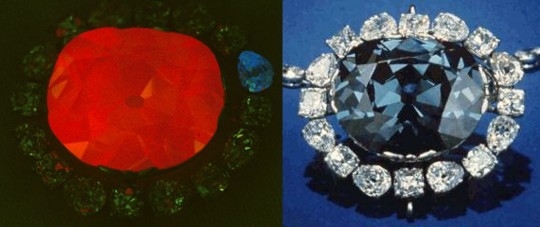
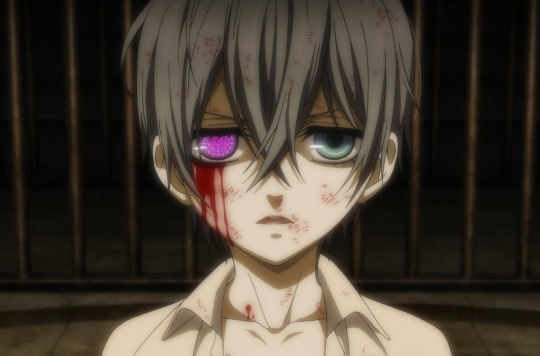
You likely know this gem as The Hope Diamond, which is a recut section of the French Crown Jewel, which itself was cut from a diamond called "The Tavernier Blue", originally purchased by a French merchant in 1666 (yikes) in India, who then sold it to King Louis XIV, who is also known as Louis le Grand (the great) or le Roi Soleil (the Sun king).
Louis XIV's great grandson, Louis XV, had the diamond (as well as other gems) reset into a pendant for "l'ordre de la Toison d'or"- "The Order of the Golden Fleece". We will discuss this pendant more in Part 3, but it fell into disuse after Louis XV's death. It became property of Louis XV's grandson, Louis XVI, who married the infamous Marie Antoinette (also referenced in season 1 of the anime in relation to both the Hope Diamond and to Undertaker). Antoinette used many of the French Crown Jewels for personal adornment by having them reset - however, this pendant of The Golden Fleece stayed intact through their reign.
On September 11, 1792, while Louis XVI and his family were imprisoned in the Square du Temple during the early stages of the French Revolution's Reign of Terror, a group of thieves broke into the Royal Storehouse—the Hôtel du Garde-Meuble de la Couronne (now Hôtel de la Marine)—stealing most of the Crown Jewels in a five-day looting spree. While many jewels were later recovered, including other pieces of the Order of the Golden Fleece*, the French Blue was not among them and it disappeared from history.
A likely scenario is that the French Blue, sometimes also known as the Blue Diamond, was "swiftly smuggled to London" after being seized in 1792 in Paris. But, the exact rock known as the French Blue was never seen again, since it almost certainly was recut during this decades-long period of anonymity, with the largest remaining piece becoming the Hope Diamond.
*this is misleading - so far as I can tell, the only other piece of the Order of the Golden Fleece that was recovered is le Côte-de-Bretagne, the red dragon. This piece is now in the Louvre.


Is it terrible for me to say I see a resemblance between the dragon and Undertaker lmao?
So the French Blue (and le Côte-de-Bretagne, and perhaps the rest of the Order of the Golden Fleece) was smuggled to London... But I'm going to pause here, and talk about another gem that disappeared - the Hirsch Aquamarine.
The Hirsch Aquamarine
Not nearly as well known as the French Blue, this is a gem that was in the possession of Louis XV, the same King who had the French Blue reset into the Order of the Golden Fleece. (Fun fact, King Louis XV was also the one to cede 'New France' to the British... And so New France would became Quebec).
I have been unable to find a lot of details on the Hirsch Aquamarine - supposedly King Louis found having it on his person to be soothing. There is no record of it being sold, or even stolen - it simply disappeared.
Well, I'm going to say it was stolen. And this was the thief - j'accuse...!
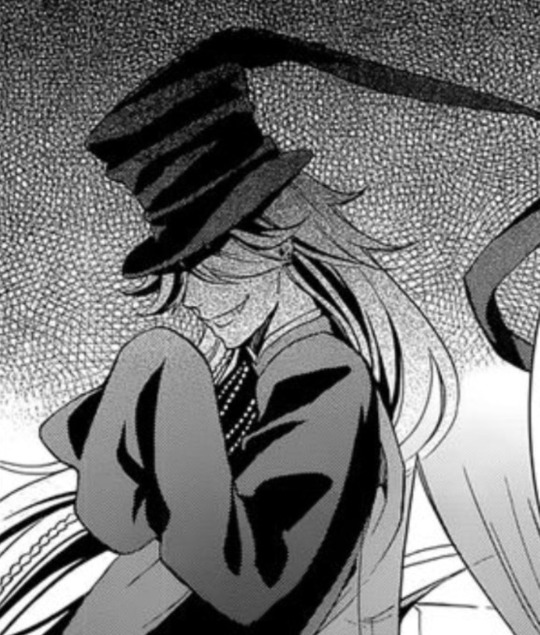
I propose that reaper 136649 knicked it while on the job.
It is not noted as being among the gems that were stored at the hotel from which the Order of the Golden Fleece, or indeed being in the posession of a King after Louis XV. Perhaps he reaped Louis XV's soul when he died in 1774. Perhaps Louis XV, who found the gem soothing, had it on his person at his time of death (his cause of death was smallpox), and Undertaker decided to grab a little momento of their time together.
Why?
Well... He's obviously sentimental. We will leave it there for now.
So let's say Undertaker stole the Hirsch Aquamarine while on the job - how did he end up with the remainder of the missing Order of the Golden Fleece? Let's return to the French Blue, the Côte-de-Bretagne, and conceivably the rest of the Order of the Golden Fleece being smuggled to London
The Recutting of The French Blue in London
Historians suggested that one burglar, Cadet Guillot, took several jewels, including the French Blue and the Côte-de-Bretagne spinel, to Le Havre and then to London, where the French Blue was cut in two pieces. Morel adds that in 1796, Guillot attempted to resell the Côte-de-Bretagne in France but was forced to relinquish it to fellow thief Lancry de la Loyelle, who put Guillot into debtors' prison.
So in 1792 the Order of the Golden Fleece is stolen from a French hotel, and smuggled to London. The Côte-de-Bretagne then turns back up in France in 1796, and eventually it is sold to the Louvre in 1887. So we know in the manga, Undertaker is not in possession of this part of the insignia. Him being the dragon has more to do with symbolism of the dragon who guards the Golden Fleece in the Greek myth, and the symbolism of being from Brittany - but I'm getting ahead of myself.
However... It's looking more and more to me like we will end up going to Paris in the manga, and I'm betting our little Lord will take a tour of the Louvre and see the dragon...
The next time this diamond appears in history, it is 20 years later, and in that time it has been cut into what will become known as The Hope Diamond.
A blue diamond with the same shape, size, and color as the Hope Diamond was recorded by John Francillon as in the possession of the London diamond merchant Daniel Eliason in September 1812, the earliest point when the history of the Hope Diamond can be definitively fixed. The 1812 date was just days after 20 years since the theft of the French Blue, just as the statute of limitations for the crime had taken effect.
Well that's bloody convenient.
So sometime in between 1792 and 1812 the French Blue is recut, with the Hope Diamond appearing in the jeweler Eliason's posession in 1812, and the Cote-de-Bretagne showing back up in France still in Guillot's posession, but none of the other gems. Those - there is no record of what happened to them, nor what happened to the other recut portion of the French Blue.
Now, an oft-cited source peaked my interest, so I went ahead and tracked down a copy of the book Blue Mystery: The Story of the Hope Diamond, written by Susanne Steinem, published in 1976. Within it is a list of the supposed deaths that trail the owners of the diamond. I went searching for something specific on a hunch - and boy, did I strike gold.
7. Wilhelm Fals, a Dutch diamond cutter, is said to have recut the French blue, producing a brilliant of 44 1/2 carats. He then supposedly died of grief after his son, Hendrik, stole the diamond. As for Hendrik, he is said to have committed suicide in London in 1830. 8. Francois Beaulieu is said to have obtained the diamond from "a nameless suicide" presumably Hendrik Fals. Beaulieu was supposedly forced to sell it to Daniel Eliason for a fraction of its value - and then died the next day of starvation.
Hendrik Fals, whose father cut the French Blue, and who himself was in possession of the Hope Diamond in 1830, killed himself.
Now you might be scratching your head going wait, what? You just said the ring showed up in London at Eliason's place in 1812, but in this version of events he wouldn't have gotten it until after 1830. I also don't mean to be insensitive - Hendrik Fals was (supposedly) a real person, and if it's true that he committed suicide, that's incredibly tragic.
To be completely frank, the author of this book says that there is no evidence for this sequence of events - it's the mythology of the ring. There are a ton of events detailed in the book as legend that have no basis in fact. That the diamond is cursed is itself a myth (I mean, duh, but also in that there are not a weird number of deaths that follow it).
However - I 100% believe Yana Toboso has read this book. The fucking title is Blue Mystery. Hendrik Fals, in the Black Butler universe, is now a Grim Reaper.
And he became a Grim Reaper in 1830 - and Undertaker likely didn't desert until 1837, around the time of Queen Victoria's ascension to the throne.
Now, Undertaker still being with the reapers between 1819 and 1837 is weird, given that the massacre at reaper HQ of 1819 wiped out half of management. I doubt our boy 136649 is just chilling in the employee lounge after pulling a stunt like that. But I am certain at some point Hendrik and 136649 met, and well, if I wanted to know where the gems from the Order of the Golden Fleece were, Hendrik Fals would be an excellent place to start.
Other Posts
Like I said, I tried to google to see if this has been discussed before and came up mostly empty (again, obviously, there has been a lot of discussion on the hope diamond but nothing I could find in the context of the other French Crown Jewels). Let me know if I missed something!
I did find an old post discussing a poem that was referenced in the Public School Arc between @abybweisse , @thaliaarche and @white-queen-lacus that referenced Beryl which is interesting. Seems like the poem also mentions shades of the dead, and the river Lethe from Greek mythology which I referenced in my Rossignol theory post and part 2 of my Floire et Blancheflor series.
That's All For Now!
If you made it this far, you deserve a medal...or a knightly order.

I really tried to fit this all into one but I'm going to have to split it. Next Part will focus on analyzing the other gems in the insignia of Louis XV, a look into the elements that make up these gems, how the Bazu is likely to be the 'sister diamond' of the Phantomhive family ring instead of another piece of The French Blue, the properties of yellow sapphires and how they might relate to blood (more spectroscopy for me whoopee), how the Dragon, Bazu Diamond, and Golden Fleece symbolize Undertaker and the twins, the Order of the Golden Fleece and its History, and of course the myth of the Golden Fleece itself.
A sheepskin is a brutal fucking metaphor - I'm sure you can guess what comes next, it's not a new theory.
If you liked this theory, you can take a look at my other theories via this masterpost that I will update as I crank these out. The theories I've developed mostly have to do with French history, French Christianity, Breton culture, and medieval French literature... I hope and pray chemistry does not become a trend.
I hope you enjoyed my insane rambling, my ask box is open and I'm always happy to talk about this stuff and thanks so much for reading!
#buckle-up chucklefucks#kuroshitsuji theory#undertaker theory#you best believe i wrote this entire thing to a 'drip' playlist#i would like to personally dedicate this theory to the slayyyter gimmie more remix#if my man gave me a blue cursed rock from the french crown jewels I'd definitely be throwing him a bone 😏#I'd let him toss my lettuce (salad on the side)#black butler#the phantomhive family ring#undertaker's ring#cedric k. ros#cedric k ros#kuroshitsuji#undertaker x claudia#undertaker x cloudia#ciel phantomhive#cloudia phantomhive#claudia phantomhive#The French Crown Jewels Theory#Um IDK all the tags apply#r!ciel#o!ciel#The Golden Fleece#undertaker#i resisted the urge to name this the family jewels theory#be proud of me#black butler theory#Claudiataker theory#I am terrified of Yana Toboso
55 notes
·
View notes
Photo

Depiction of Bael, “the first king of hell”, with the head of a toad, a man, and a cat — one of the many illustrations by Louis le Breton for the 1863 edition of Jacques Collin de Plancy’s "Dictionnaire infernal". More here: https://publicdomainreview.org/essay/defining-the-demonic
70 notes
·
View notes
Text
Twisted Wonderland's Grim is a Grimalkin.
Okay TWST fandom, so today I was chatting away with another friend who plays TWST explaining that it's highly likely that Crowley summoned us due to the opening you get when you first start the game and she asked why he'd do that. And I said this without thinking:

Once I said that, it hit me: GRIM IS NOT NAMED FOR GRIMM'S FAIRY TALES, HE'S A GRIMALKIN.
Let me explain! (This is a long post, you've been forewarned. There is a TLDR at the bottom if you need it.)
So I like reading fairy tale books, retellings, etc., and I learned a long time ago during my high school hyperfixation on reading faery based YA readings about Grimalkins. What are Grimalkins?
Grimalkin (Also spelled Greymalkin) is an archaic term that was often used to describe cats; particularly haggard, female cats. Grimalkin, according to the Oxford English Dictionary, likely comes from compounding the words "Grey" and "Malkin". "Malkin" is a term with several meanings including: a low-class woman, a weakling, an untidy slovenly woman. It's also used to describe cats and hares.
Grimalkins were listed in Scottish legends as a faery cat that dwelt in the highlands, but during the 16th Century witch trials, cats became associated with the devil and witchcraft. Women on trial in Scotland were frequently accused of having a familiar, a ‘demon in disguise’, which was often a Grimalkin. One example of Grimalkins being tied to witchcraft and the devil at the time is William Shakespeare's play MacBeth, which shows the Three Witches who foretell Macbeth's future as having a cat familiar named Grimalkin. They're also in Louis Le Breton's Dictionnaire Infernal, which is a book on demonology.

So how does this relate to Grim?

Grim's design is heavily influenced by common media portrayals of the Devil with a pitchfork tail and fiery pointed ears that can look like horns at times.

One reason that fire is blue like Hades, Idia, and Ortho's hair is because thanks to the Pop Culture understanding of Christianity, people heard Hades and thought to equivocate him to Satan which is why he's the bad guy in the Disney movie, Hercules, when in the original myth, Hera is the one antagonizing Heracles.
Also, most of the fandom believes this creature in the pre Prologue scene when you first start the game, is Grim.

Just saying this looks a lot like different representations of devils and demons.

Note the human hands and clawed feet on this statue of Pazuzu.

And the incorporation of animal traits blended with humans

This is some concept art for Bald Mountain in Fantasia and I can see leathery wings like a dragon/bat, one has a snakey tail, and some have those human-like hands, but clawed feet.
As stated earlier, Grimalkins are tied heavily to devils and witchcraft and TWST tends to push this at us. For Halloween, while all the Dorms have different monsters such as mummies, ghost pirates, headless horsemen, but Ramshackle's Halloween outfit is this:

Not only that, but when we wake up, this is what Crowley says to us about Grim, when he finds us in the library after Grim cornered us, trying to get our robes:

Again, the most common familiar that people accused of witchcraft were said to have was a Grimalkin. A demon cat. This also ties into why we and Grim are put in Ramshackle Dorm.
Now, as some know, Ramshackle Dorm is based on the Haunted Mansion. But the Haunted Mansion had a specific haunt that was cut before the ride came out: The One-eyed Black Cat.

Now, if you don't know this cat, it's okay. He was cut before the ride came out. To sum up, X Atencio, the Imagineer who came up with the basic story ideas and the script for the rides of Haunted Mansion and Pirates of the Caribbean, had many drafts of the Haunted Mansion's story. One of these cut drafts had a distinct villain character: The One-Eyed Black Cat.
Now, people might argue the Bride/Constance Hatchaway is the villain of the Haunted Mansion, but the One-Eyed Black Cat was different. In that draft, the Ghost Host would warn guests about the One-Eyed Black Cat and the One-Eyed Black Cat was specifically trying to attack/get the guests on the ride and detested mortals, especially happy ones. Guests would've seen signs of the cat throughout the ride as if he was stalking them (Think something akin to the little glimpses of Catnap as he stalks the player throughout Poppy Playtime Chapter 3). At the end of the ride, they would've faced the cat, who's face would turn into some form of human-esque skull like head.


Now the cat made it pretty far before he was cut, because we do have surviving sound outtakes of Paul Frees, the voice of the Ghost Host, saying "Except for that unnatural and dreadful one-eyed black cat" which implies he's not one of the 999 happy haunts, but something truly evil, like a demon.
Now, One-Eyed Black Cat's not mentioned in the Haunted Mansion ride, and there's an idea that his role was passed over to the Raven, another cut antagonistic character who would haunt the rider specifically, but was less unnatural than the cat, but the more likely reason is both the raven and the cat were cut due to the ride changing from story driven to an atmospheric ride. However, nowadays, you can find the One-Eyed Black Cat on the Composer's Crypt in Walt Disney World and as a statue in Disneyland's Haunted Mansion (Funnily enough, during the Haunted Mansion Holiday, the cat statue gets a black and white pinstripe bow...).


Now, this may be reaching, but Grim chasing the player throughout the school, trying to steal their robes because he wasn't allowed to attend NRC, feels like a reference to this possibly demonic cut cat character. Also, his smirk face does make one of his eyes look smaller than the other, kind of like the image on the Composer Crypt.

Anyways, back to Grimalkins. So besides being tied to the devil and witchcraft, Grimalkins were also known as Scottish faery cats. Why does this matter? May I draw your attention to these moments from Book 6 and Book 7?
(Warning minor spoilers)

Idia discussing what Grim is.




Idia and Ortho describing powerful magic cast on Grim.
And from Book 7 Chapter 106


Soi in Book 6, Idia notes Grim is some magical mix of direbeast and animal. In a lot of faery stories, faery animals like Grimalkins, Cat Sidhe, and Kelpies look very similar to normal animals, but they are distinctly a fae, which makes them much more dangerous to mess around with. Much like how Grim is not fully an animal, he's also part direbeast which, considering what has been mentioned in game about direbeasts, sounds like a distinctly magical species that is far more dangerous that regular animals.
Grim is also noted to fluctuate between full Phantom and absolutely no blot levels, but Idia does note a complex magical spell on him that later Papa Shroud mentions is very similar to Malleus's magical realm, which is a faerie spell... (Again, there's that faerie connection). Likewise, depending on the story context, Grimalkins can either be demonic familiars to witches (more akin to TWST Phantoms) or they can be faery creatures (more like TWST Direbeasts).
I've also noticed people point out some kind of connection between Malleus and Grim. There's a blog post by ventique18 does a really good job about pointing out the similarities between the two. Here's the link: https://www.tumblr.com/ventique18/721267245925400576/three-pronged-tail-bringing-back-the-grim-is?source=share
So perhaps one of the reasons for the tie between them is Grim is at least in part based on a Grimalkin, a faery cat, and Malleus is a dragon faery. With all these little things lining up, maybe Grim got his name in part from Grimm's Fairy Tales, but I really and truly do believe Grim is some form of Grimalkin and his name is more a reference to that, but whether he is based on the demonic familiar, faery, or BOTH, we shall see.

TLDR: I'm pretty sure Grim is HEAVILY based on a Scottish fae cat creature/demonic cat that act as a witch's familar called a Grimalkin because there's a lot of references that seem to point to that.
#Grim is a grimalkin#there's so many similarities#disney twisted wonderland#twisted wonderland#twst#twst en#disney twst#book 7 twst#twst grim#grimalkin#grim twst#twisted wonderland ramshackle dorm#one-eyed black cat#disney haunted mansion ride#the haunted mansion
48 notes
·
View notes
Text

“Diable” by Louis Le Breton in Dictionnaire Infernal by Collin de Plancy (1863) 🤘🖤
Wikimedia Commons
#dictionnaire infernal#louis le breton#diable#collin de plancy#demons#demonolatry#theistic satanism#satanic witch#spiritual satanism#dark pagan#dark paganism#witchcraft#witchblr#paganblr#occult#19th century art#dark art#art#left hand path#spirituality
30 notes
·
View notes
Text

The Astrolabe stuck in ice on 6 February 1838, by Louis Le Breton, 1846
#naval art#antarctic exploration#jules sébastien césar dumont d'urville#french expedition#1838#age of sail
211 notes
·
View notes
Photo










1863 edition of the Dictionnaire Infernal by Jacques Collin de Plancy with illustrations by Louis Le Breton.
291 notes
·
View notes
Text
The Bastardised Interpretations Of Daemons (And Other Spirits) Within The Dictionnaire Infernal

+. GIF Credit .+
•──────⋆༺🕸༻⋆──────•
So I got the idea for this post from my best friend @sortiarus-de--naturas--daemonum, and we both agreed that this was something that needed addressing; Especially in regards to Daemonolatry.
The Dictionnaire Infernal is one of the most widely known grimoires on demonology and all things occult. But what a lot of practitioners might not know is that it's actually quite a problematic resource for Daemonolatry and occult practices, and for several reasons. In fact, I personally don't think it's a reputable source in general, and this post is going to be detailing exactly why that is.
So without further ado, here's why the Dictionnaire Infernal might not be the greatest resource for Daemonolatrists, and why it's much more problematic than you think!
Full post under the cut. ↓
•──────⋆༺🕸༻⋆──────•
So, why is the Dictionnaire Infernal a bad resource for Daemonolatry and daemons in general? Well...
For starters, the book was written by someone who had very, very problematic views on other religions and belief systems... As in, racism, xenophobia, and religiophobia kind of problematic.
On top of that, Jacques Collin De Plancy (the author) had converted to Catholicism by the time he had started writing the Dictionnaire Infernal. So at this point, he was already going to have a biased interpretation of the Daemonic Divine, as he was interpreting them through a Christian-tainted lens; That is, in comparison to someone who seeks to learn about and venerate them. As a result, the entries on the daemons within his book were evidently written to play into the vilifying and denigration of daemons in general.
And to add insult to injury, a later edition was published with added illustrations, likely commissioned by De Plancy and drawn by Louis Le Breton, showcasing bastardised interpretations of daemons and demonised deities, interpreting them to look as monstrous and hideous as possible.
All around, it seems that both the spirits' entries and their illustrations were made with the main intent to mock and degrade them, as well as to portray them as being mere dirt beneath the feet of the Christian God. Obviously, a book portraying daemons in such a way is not going to be very helpful to a Daemonolatrist. If one wants to honour and work with daemons, what use is such a book that primarily mocks their very existence going to be?
Don't get me wrong; I think it's okay to go to the Dictionnaire Infernal for research, but only with the foreknowledge and understanding that the lore and mythology of the daemons and other spirits listed therein runs much deeper than the mere entries within the book, and that you shouldn't rely on it as your sole source of information on the Daemonic Divine.
But aside from these glaring issues, the Dictionnaire Infernal is just iniquitous and amoral in general; Which is no surprise, given that it was written in the 19th century and people back then held some very problematic beliefs... But that doesn't make any of it okay.
So, what other issues lie within the pages of the Dictionnaire Infernal? Let's delve into them...
•──────⋆༺🕸༻⋆──────•
◦──⋆ I ⋆──◦
~ Demonising Deities Of Other Religions ~
Something I noticed from the get-go was the fact that De Plancy is very quick to declare deities from other belief systems as Christian demons who oppose God, when they're historically not documented as such. He did this with several Hindu deities such as Bhairava, Ganga, Kali, Durga (a.k.a. Deumus), Kateri, and Garuda. The illustrations of these deities drawn by Le Breton seem to be quite shocking and possibly kind of racist as well.
I mean, take these depictions of Bhairava (left) and Kali (right) for example, and they seem to speak for themselves. I don't know for sure if these depictions are racist or not, but they definitely feel like they might be...
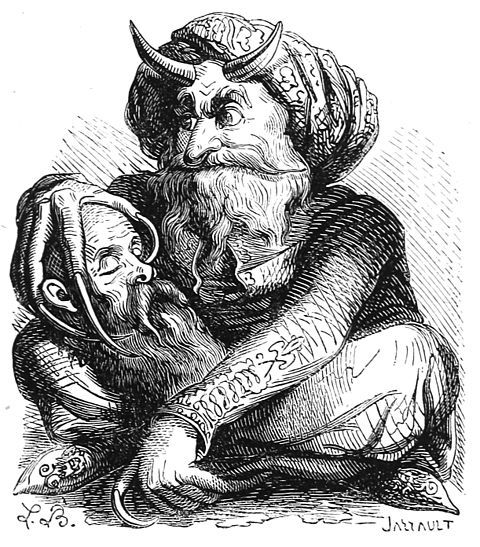
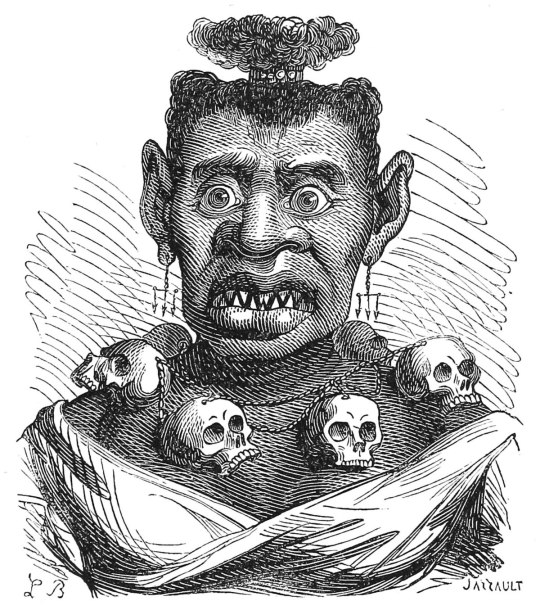
At the very least, they seem to be extremely bastardised and monstrously grotesque misrepresentations of these deities. See these more historically accurate depictions below for comparison:
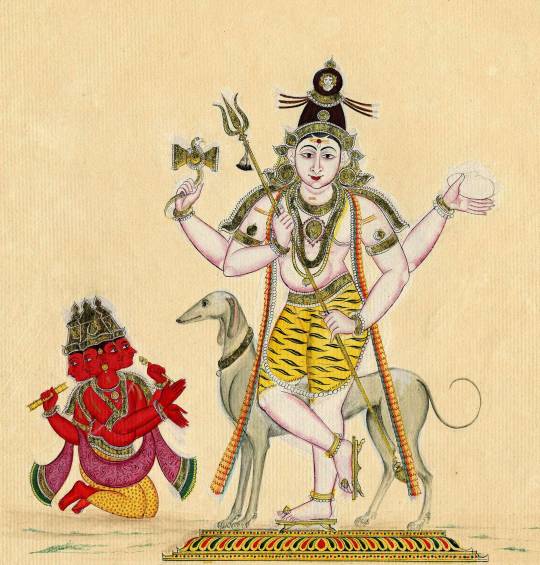
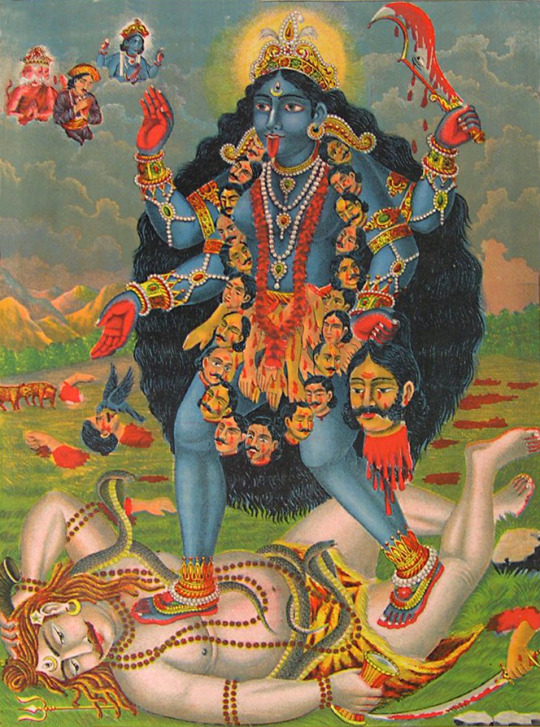
De Plancy also included entries on deities and entities such as Abraxas, Adrammelech, Alastor, Astarte, Chemosh (Chamos), Dagon, Dumuzid (Tammuz), Flaga, Guayota, Hadad (Rimmon), Milcom, Moloch, Nergal, Nibhaz (Nybbas), Nisroch, Pan, Peckols (Picollus), Pluton, Proserpina, Pucks, Rubezahl (Ribesal), Succoth-benoth, Torngarsuk, and many others that were criminally misrepresented and twisted into something they weren't.
It likely only reinforced the idea of deities such as Moloch, Chemosh, Dagan, Adrammelech, and Abraxas being considered Christianised "demons" rather than simply just deities pertaining to other religions and belief systems. Even mere underworld deities tasked with watching over the dead in the afterlife (e.g. Peckols, Pluton, Proserpina, Nergal, Dumuzid) were tainted with the stereotypical Christian idea of Hell; Fire, brimstone, pain, torment, and suffering for all of eternity.
And while some forgotten gods of dying religions might take a liking to being embraced as daemons or daemonic deities worthy of veneration in the context of Daemonolatry (as long as it's done in a respectful manner of course), these deities have still been obscenely misrepresented through the distorted perception of De Plancy's problematic views on other religions.
And that leads us into his similarly skewed views on the Daemonic Divine themselves, which isn't any better...
•──────⋆༺🕸༻⋆──────•
◦──⋆ II ⋆──◦
~ The Monstrous Misrepresentation Of Spirits ~
So not only was De Plancy a racist religiophobe (which was already rather obvious lol), but he was also quite uneducated on daemons as a whole; That is my personal opinion as both a Daemonolatrist and a Daemonologist. Having converted to Catholicism, this likely made his perception and interpretation of daemons extremely biased, because it's quite commonplace for Christianity to depict daemons in a grossly negative light.
They're basically viewed and treated like they're evil incarnate and are frequently scapegoated for most of the world's problems by religious extremists, even in the modern day. As someone who has a lot of love and respect for the Daemonic Divine, these ideas criminally misrepresent the daemons I know and love; And that goes for how they're portrayed in the Dictionnaire Infernal as well.
On top of De Plancy having a warped perception of daemons, he also seemed to have limited knowledge of the Daemonic Divine beyond their grimoire appearances; He didn't seem to have much of a UPG on them (other than the fact that he believed they were literal fallen angels who disobeyed god and were cast out of Heaven as a result), which is probably because he was biased, and didn't care to see daemons in a different perception beyond the Christian interpretation of them being the "villains".
From the thorough research I've done, it seems much more likely that daemons originate from deities pertaining to pantheons of other religions and belief systems, rather than being literal fallen angels. But that's for a whole other post in and of itself.
Aside from deities such as Baal and Astarte already being bastardised into the daemons Bael and Astaroth, as well as being depicted as such in the Dictionnaire Infernal, De Plancy himself also misinterpreted and misrepresented several deities and spirits of other folkloric backgrounds. This is very evident in his "hellish hierarchy" of spirits he considers demons included within his book. He also assigns absurdly inaccurate roles to them too. Here are just a few examples:
Kobal - This is likely a demonisation of both the Kobold sprites of Germanic mythology and the Kobaloi sprites of Greek mythology. Kobolds were commonly considered household spirits who stirred up mischief around the home. In some accounts, they were also known to do chores at night that humans neglected to finish during the day. Kobaloi were said to be impudent and mischievous spirits that were fond of tricking and frightening mortals. They were companions of Dionysus and also had the ability to shape-shift. De Plancy represented these sprites as a singular demon and assigned him with directing theatres and being somewhat of a "stage manager" in Hell.
Nybbas - This is a demonisation of a supposed deity of the Avim called Nibhaz, worshipped during the reigning of Shalmaneser I, mentioned in 2 Kings 17:31 of the Bible. Nibhaz is a rather obscure Mesopotamian deity mentioned in the Bible who was either 1) A deity whose history and mythos has been lost to time, or 2) A deity that likely never even existed in the first place. Thus, there's barely any information on Nibhaz, other than the fact that they apparently appeared in the form of a dog. De Plancy portrayed this deity as a demon under the name of Nybbas, who was in charge of managing the visions and dreams of mortals. He was said to be treated with little respect, and was regarded a "buffoon" and "charlatan".
Nergal - Here's another Mesopotamian deity that was mentioned in 2 Kings 17:31 and later demonised by De Plancy, though, Nergal seems to have a much more pronounced mythos. Nergal was a chthonic god associated with plagues, war, pestilence, death, and devastation. However, he was also said to be a benefactor to mortals; Hearing their prayers, reviving the dead, and protecting agriculture and flocks. He was equated with Irra, a god of war and scorched earth. This is probably why Nergal was later regarded as a "destroying flame" and described as "scorching". De Plancy assigned him with the role of being chief of Hell's "secret police". He is also listed as the first spy under Beelzebub's command who, in turn, is under the surveillance of "the great vigilante" Lucifer. I have absolutely no idea why Hell would even need secret police or where he even got that idea in the first place, but go figure lol. That's De Plancy for ya.
Proserpina - As far as I know, I don't think Proserpina was actually demonised prior to her appearance in the Dictionnaire Infernal. It seems that her entry within the book is the first time she was ever demonised. Proserpina is a Roman goddess (Greek equivalent: Persephone) of fertility, nature, agriculture, vegetative growth, the underworld, and the season of Spring. She is best-known for the myth of her abduction to the Underworld by the chthonic god Hades (Roman equivalent: Pluto). De Plancy includes her in his "hellish hierarchy" where he regards her as an archdiablesse (French for "archdemoness" or "arch-she-devil") and princess of evil spirits. In her grimoire entry within the Dictionnaire Infernal, she is described as being queen of the infernal empire and is associated with serpents and snakes.
Hutgin - This is another case of De Plancy demonising sprites and faeries. Hutgin is likely a demonisation of Hodekin, a kobold or sprite of Germanic folklore. Hodekin was said to be a helpful sprite and somewhat of a familiar spirit who lived with the Bishop Of Hildesheim. Hodekin was said to mainly be a nocturnal spirit and only active at night. He could see into the future and could warn one of problems to come. One of the myths surrounding Hodekin is that he was tasked with watching over the bishop's wife to make sure she remained faithful while he was away. Whenever she tried to cheat on the bishop, Hodekin would step in and assume frightening shapes, scaring the paramours away before the wife could be unfaithful. De Plancy assigns Hutgin with the role of being Hell's ambassador to the country of Turkey (for whatever reason lmao).
I don't really know how De Plancy came to such conclusions regarding daemons, deities, and other spirits; But clearly, a lot of these depictions are not very historically accurate lol. And that leads us into the next section of this post, where the depictions of the Daemonic Divine in particular weren't exactly without error in comparison to their other grimoire appearances.
•──────⋆༺🕸༻⋆──────•
◦──⋆ III ⋆──◦
~ The Inaccurate Depictions Of Daemons ~
A lot of people in occult spaces are likely familiar with Le Breton's illustrations within the Dictionnaire Infernal. However, what a lot of people don't know is that the illustrations and grimoire entries aren't very historically accurate depictions of the Daemonic Divine; That is, when you compare them to the daemons' original grimoire appearances in books such as the Livre Des Esperitz, Fasciculus Rerum Geomanticarum, Liber Officiorum Spirituum, and the Pseudomonarchia Daemonum. From the disparaging illustrated depictions to the bastardised lore, the Daemonic Divine aren't exactly documented so accurately within the Dictionnaire Infernal. Let's delve into some examples:
- - - - - - - - - -


Pruflas (also called Bufas, Suffales, Bulfas, Pruslas, and Busas) is a daemon that appears in the Livre Des Esperitz, Liber Officiorum Spirituum, Pseudomonarchia Daemonum, and the Dictionnaire Infernal.
In the Dictionnaire Infernal, Pruflas is depicted as a man with the head of an owl. But for some reason, his illustration depicts Purson rather than Pruflas (Purson is described as a lion-headed man riding a bear, also being associated with trumpets). Perhaps this was either some sort of error, or De Plancy and/or Le Breton considered Pruflas and Purson to be the same daemon, even though this is not stated anywhere in the Dictionnaire Infernal.
In the Livre Des Esperitz, Pruflas's appearance is not described. In the Liber Officiorum Spirituum, he is said to appear as a spark of fire. In the Pseudomonarchia Daemonum, he is said to appear with the body of a fiery flame and the head of a nighthawk or nightjar (described as "nycticoraci" in the original Latin version).
The term "nycticoraci" or "nycticorax" is translated to "night raven" in English. This term likely originates from Leviticus 11:16 of the Bible, which regards the "night raven" as any bird of ill omen. The specific birds regarded as night ravens mentioned in Leviticus 11 are; Eagles, vultures, black vultures, red kites, black kites, ravens, horned owls, screech owls, gulls, hawks, little owls, cormorants, great owls, white owls, desert owls, ospreys, storks, herons, hoopoes, and bats (even though bats aren't birds lol).
Later, the term "nycticorax" was used to name a specific genus of night herons. It was specifically also used to refer to the best known species, the black-crowned night heron. Given that the term "night raven" can refer to any bird of ill omen in Christianity, this may explain why daemons such as Stolas, Andras, and Aamon are depicted as either being owl-headed or taking on the appearance of an owl.
- - - - - - - - - -

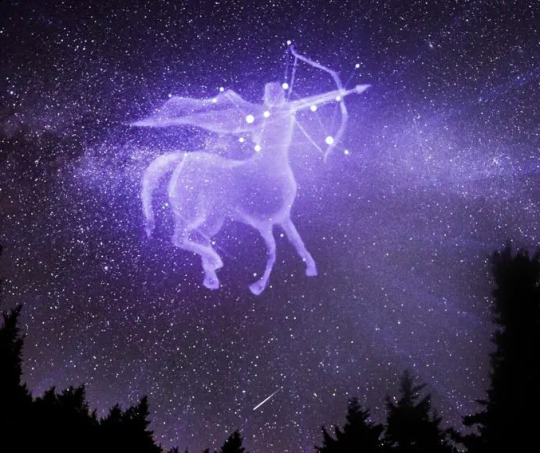
Buer (also called Gemer) is a daemon that appears in the Livre Des Esperitz, Pseudomonarchia Daemonum, Ars Goetia, and the Dictionnaire Infernal.
In the Dictionnaire Infernal, Buer is depicted as appearing in the form of a star or five-pointed wheel. Le Breton's illustration depicts him as a disembodied lion's head with five goat legs, giving him the ability to "walk" or roll in all directions. This is a historically inaccurate depiction of how Buer appears, because he isn't depicted as a quintuple-goat-legged lion head in any of his grimoire appearances whatsoever.
In the Livre Des Esperitz, Buer's appearance is not described. In the Pseudomonarchia Daemonum, he is said to appear in the form of a star. In the Ars Goetia, he is said to appear in the form of a "sagittary" or centaur, specifically when the Sun is in Sagittarius.
Buer is likely a demonisation of Chiron, a superlative centaur from Greek mythology who specialised in healing, medicine, and astrology; Which explains Buer's similar functions and the account of him appearing in the form of a "sagittary" in the Ars Goetia.
- - - - - - - - - -

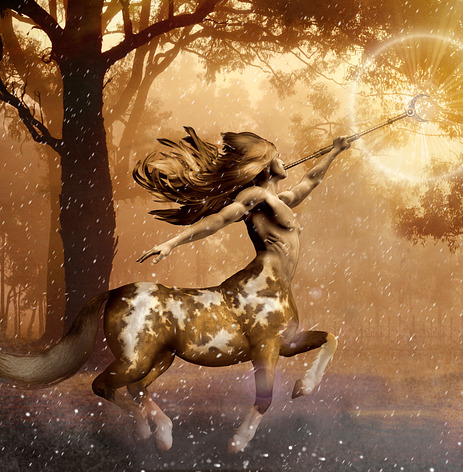
Barbatos (also called Barbates, Barbares, Barbais, Barbas, and Barbarus) is a daemon that appears in the Livre Des Esperitz, Munich Manual Of Demonic Magic, Liber Officiorum Spirituum, Pseudomonarchia Daemonum, Ars Goetia, and the Dictionnaire Infernal.
In his Dictionnaire Infernal illustration, Barbatos is depicted as a bearded hunter wielding a hunting rifle, and he is said to inhabit the forests. In his grimoire entry, he is alternatively said to appear as an archer. He is also compared to Robin Of The Woods (a.k.a. Robin Hood) and Jack In The Green.
In the Livre Des Esperitz, Barbatos's appearance is not described. In the Munich Manual Of Demonic Magic, he is said to appear as a forest archer who is accompanied by four kings carrying trumpets. In the Liber Officiorum Spirituum, he is said to appear in the form of a shouter, forest man, or wild archer. Alternatively, he is also said to appear as a centaur or "sagittary" that is described as being "half-man and half-beast". In the Pseudomonarchia Daemonum, he is said to appear in the form of a woodland archer. In the Ars Goetia, he is said to appear in the form of a "sagittary" or centaur, specifically when the Sun is in Sagittarius; Similarly to Buer.
While his form described in the Ars Goetia is said to be a mistranslation, it's not technically an inaccurate depiction. He appears as a centaur in the Liber Officiorum Spirituum, after all. His depiction as a forest man isn't too inaccurate either, given that Barbatos is possibly tied to the mythical figure Woodwose originating in medieval Europe, and functions similarly.
- - - - - - - - - -
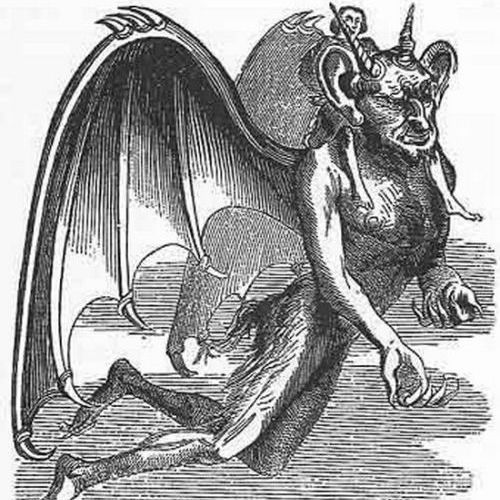

Gaap (also called Tap, Goap, Coap, Taob, Ducay, and Balath) is a daemon that appears in the Livre Des Esperitz, Munich Manual Of Demonic Magic, Liber Officiorum Spirituum, Pseudomonarchia Daemonum, Ars Goetia, and the Dictionnaire Infernal.
In the Dictionnaire Infernal, Gaap is said to appear at noon in human form. But in his illustration, he is depicted as a devil-like figure, or more plausibly, as a man riding upon the shoulders of a devil-like figure. Many people have interpreted this illustration as the demon figure being Gaap himself. But given his Dictionnaire Infernal entry, it's probably more likely that Gaap is the human mounted on the shoulders of the demon-like figure.
In the Livre Des Esperitz, Gaap's appearance is said to appear "very benignly". In the Munich Manual Of Demonic Magic, he is said to appear as a healer that assumes human form, and is also regarded as a doctor. In the Liber Officiorum Spirituum, he is said to appear as a misshapen image. In the Pseudomonarchia Daemonum, he is said to appear in a "meridional sign". In the Ars Goetia, he is said to appear in human form when the Sun is in the Southern signs.
As previously stated, it's likely that many people have interpreted Gaap's illustration as him being depicted as the devil-like figure, instead of the man that is mounted on him. Looking at his other grimoire appearances, it's likely that the illustration was meant to depict Gaap as taking the form of a human mounted on the shoulders of a devil-like being.
- - - - - - - - - -
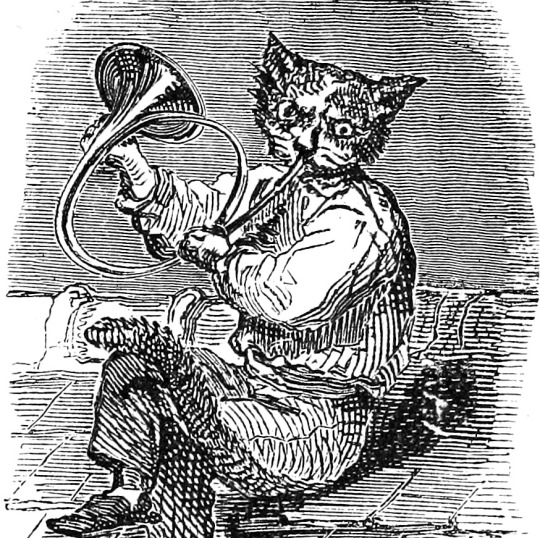

Beleth (also called Bileth, Bilet, and Byleth) is a daemon that appears in the Liber Officiorum Spirituum, Pseudomonarchia Daemonum, Ars Goetia, and the Dictionnaire Infernal.
In the Dictionnaire Infernal, she is said to appear as a "terrible" king riding a white horse, preceded by cats blowing horns and trumpets. However, her illustration seems to depict her as cat-headed person playing a horn, surrounded by dancing mice. Perhaps this illustration was meant to depict one of the horn-blowing cats that precede Beleth? I'm not sure.
In the Liber Officiorum Spirituum, Beleth's appearance is not described. In the Pseudomonarchia Daemonum, she is said to appear furiously, riding upon a pale horse; The sounding of trumpets and the playing of all sorts of other musical instruments are heard before her. In the Ars Goetia, she appears pretty much in the same way as described within the Pseudomonarchia Daemonum.
It's also just my personal UPG that Beleth is a girl lol, as I believe she likely originated from the Mesopotamian goddess Belet-ili. As far as I know, I don't think Beleth is depicted as a woman in any of her grimoire appearances. Her Dictionnaire Infernal entry and illustration don't seem to align either, so it's likely that the trumpet-blowing cat drawing was meant to depict the cats that precede Beleth, rather than Beleth herself.
- - - - - - - - - -
These are just a handful of the inaccurate depictions of the Daemonic Divine and other spirits within the Dictionnaire Infernal. If I were to delve into all of them in great detail, this post would be far too long... So I'm gonna end it there lol.
•──────⋆༺🕸༻⋆──────•
In conclusion, I personally don't advise going to the Dictionnaire Infernal as your sole source of research on daemons; Especially if you're a daemonolatrist. I'd instead recommend looking at their other grimoire appearances, especially the earlier ones. The grimoires I recommend looking into are:
Livre Des Esperitz
Fasciculus Rerum Geomanticarum
Liber Officiorum Spirituum
Pseudomonarchia Daemonum
Ars Goetia
I hope you find this post helpful! And as always, I wish you well on your spiritual path. Also, a big thanks to my friend @sortiarus-de--naturas--daemonum for helping me out with this post! I could not have written this without her. 💜
•──────⋆༺🕸༻⋆──────•
❀༻ Ave Satanas ༺❀

+. Image Sources .+ ... Nightjar Photo ... Centaur Image V1 ... Centaur Image V2 ... Flower Petals Image ... Horse Rider Image ...
#daemonolatry info posts#demonolatry#demonology#demons#dictionnaire infernal#daemonic divine#paganism#daemonolatry#daemonology#pagan#daemons#witchblr#paganblr#daemonblr#infernal dictionary#demonolatry resources
39 notes
·
View notes